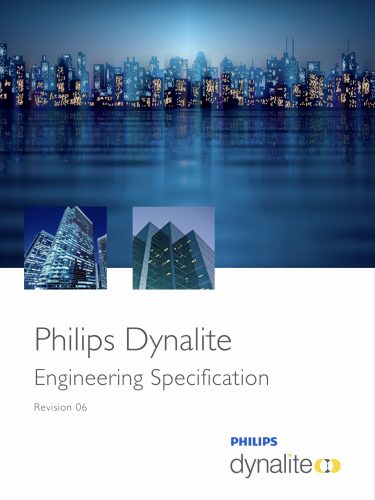
Did you know that Philips Dynalite has a comprehensive engineering specification?
This specification is a valuable resource for specifiers; designers, and consultants to specify a Dynalite lighting control system, to accurately describe a networked lighting control system in project documentation.
Being a specification resource, the document doesn’t provide specific information on each and every product, but rather a functionality specification that separates Dynalite from other lighting control systems.
It covers almost every aspect for a Philips Dynalite specification, including:
- System functionality
- Load controllers
- User interfaces
- Networking and integration
- Software
- Monitoring
Some examples of the specification:
8.2 System Functionality > Occupancy Control (page 10)
Through sensor based occupancy detection, enable management of the artificial lighting level required at any given time for vacant and occupied areas. This feature shall be capable of functioning at the same time as light level detection, especially in areas that experience high levels of daylight i.e. adjacent to windows.
8.3.2 Light Level Control > Dimming (page 11)
The system must be capable of implementing dimming control of lighting from a flexible choice of networked user interfaces. This shall be achieved by a protocol (or signal) to a lamp driver (DALI addressable, DALI Broadcast, DSI, or 1-10V) or by power control of phase control dimmers.
8.3.5 Light Level Control > Colour Component and White Balance Control (page 12)
The system shall have provision to represent and control luminaires that incorporate multiple channels for the adjustment of color (RGB) or tunable white (warm white/cool white). When integrating White Balance control in a DALI network, only one DALI address shall be used for controlling both white balance and dimming level.
9.3.2 Power Dimming Controllers > Trailing Edge Power Dimming Controllers (page 17)
Trailing Edge, (TE) dimmers shall be used on unique lighting circuits that incorporate trailing edge compatible low voltage electronic transformers. Trailing edge dimmers shall use MOSFET transistors as the power-regulating device. All trailing edge dimmers shall incorporate electronic overvoltage protection, and electronic short circuit protection. Trailing edge dimmers shall be capable of sensing an inductive load, and automatically revert to switching only if an inductive load is connected.
9.4.1 Signal Dimming Controllers > Broadcast Signal Dimming Controllers (page 18)
Signal dimming shall be used to control luminaires with integral dimming control gear. Signal dimming controllers shall use commissioning software to select the output as 1-10V, DSI or DALI Broadcast. The controllers shall optionally incorporate an integral mains supply relay for each ballast control output circuit so that power can be removed from the lighting circuit when the ballast control channel is set to 0% output (off state). The relay shall have an appropriately rated capacity for typical lighting loads. Control systems that require an external DSI or DALI converter shall not be acceptable.
Feel free to download the Philips Dynalite Engineering Specification and distribute it to your design and consultant audience.
Let me know if I can be of further assistance helping you specify a lighting control system, that will differentiate it from others.
This series of articles focuses on products from the Philips Dynalite networked lighting control portfolio. Many industry professionals regard Philips Dynalite as being the world’s best lighting control system, that I have represented with Lightmoves for many years. SimonLakey
